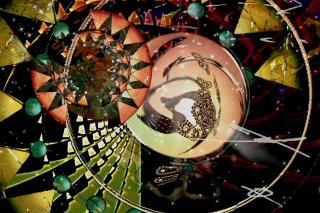Simmons Alumna Karen LaFleur Integrates Storytelling and Techspressionist Moving Images in Award‑Winning Art

In the news from the United States, Simmons University graduate Karen LaFleur ’97MA has forged a new path by blending traditional storytelling with cutting‑edge techspressionist moving images. Her work showcases how narrative and technology can coalesce into immersive art that communicates emotion and insight to viewers.
Linking Narrative to Visuals
LaFleur’s career illustrates how a strong grasp of narrative structure—acquired at Simmons’s Master of Arts in Children’s Literature program—can be extended beyond the page. She treats each visual element as a story beat, using color, motion, and composition to move audiences along a plot line that feels both familiar and profoundly new.
Story Anticipation in Video Flow
Just as a book reader anticipates the next chapter, viewers of LaFleur’s moving images build expectations between frames. She manipulates timing, transitions, and pacing to maintain suspense and release, producing a rhythm that feels akin to a well‑crafted novel.
Early Foundations: From Beach Villages to Digital Canvas
Her fascination with storytelling began as a child building miniature villages on seaside sand. Those early experiments were more than play—they were narrative constructions that invited the imagination to fill in histories and characters. These small worlds became the seed from which her adult practice grew.
Transposing Physical Worlds Into Pixels
When a first computer—a 1981 Apple IIe—arrived, LaFleur saw an opportunity to translate her physical creations into pixel‑based media. This early exposure paved the way for her later use of Photoshop, Apple Motion, and other digital tools to render complex scenes that still preserve the hand‑crafted feel of her originals.
Tech as Tool and Companion
Her work is a testament to how technology can both assist and enhance creative output. Dyslexia presented an obstacle in reading dense texts, but digital tools such as text photocopying and formatting allowed her to meet academic requirements without sacrificing pace.
From Adobe Photoshop to Final Cut Pro
Her process begins with a pencil sketch—etched on vellum—then digitized and layered in Photoshop. Each layer becomes an independent visual element that can be animated in Apple Motion, with occasional effects added in After Effects, Blender, or Cinema 4D. The final sequence is assembled with Final Cut Pro and original music from composer Nancy Tucker, resulting in a seamless narrative experience.
Master of Arts in Children’s Literature: Building Story Foundations
LaFleur credits Simmons’s program with grounding her narrative instincts. The curriculum’s emphasis on how stories move readers and how visual, textual, and sonic cues cooperate cultivated her ability to design stories that work across page and screen simultaneously.
Curricular Influence on Visual Storytelling
The coursework examined how elements such as shape, tone, and color direct reader attention. LaFleur internalized these principles to design visual storyboards that maintain narrative momentum whether flipped, animated, or projected.
Techspressionism: Combining Emotion With Technology
Techspressionism—an approach LaFleur pioneered—uses digital media to evoke emotional responses akin to expressionist paintings. By layering textures, manipulating light, and syncing rhythm, the art invites viewers into an intimate dialogue.
Participation in the Global Techspressionism Community
In 2020 LaFleur joined an online salon curated by Colin Goldberg. The community, with its international roster of artists, held monthly meetings that allowed her to share techniques and collaborate on large‑scale installations such as the 150‑foot high‑resolution video at Chicago’s 150 Media Stream.
Collaborations: Science and Art Intersect
Her partnership with Woods Hole Oceanographic Institution scientists produced the “Mariniana: The Interrupted Wave” series, where ocean eddies became living narratives. LaFleur’s work demonstrates how scientific data can fuel compelling visual stories, making complex research accessible to public audiences.
Integrating Data Into Narrative Flow
The visual compositions are built on sensor data processed into color gradients and motion sequences. The result is a moving image that respects scientific accuracy while translating it into an emotional, story‑driven experience.
Exhibitions That Captivated Audiences
LaFleur’s work has garnered international exposure: from the MoCA L.I.ghts/Light Projection Festival in 2023 to the G.MAP Media Museum in Gwangju, South Korea, and upcoming shows in Brooklyn and Chelsea. Each exhibition demonstrates her ability to scale storytelling—whether on a small screen or a multi‑meter video wall—while preserving narrative integrity.
From Local to Global Reach
Her shows have attracted tens of thousands of Instagram followers, illustrating how effective storytelling coupled with technology can amplify audience reach beyond traditional gallery spaces.
Advice for Emerging Artists
LaFleur emphasizes authenticity: “If your work speaks in its genuine language, it will speak to the people it needs to speak to.” She encourages artists to develop their voices over time, experimenting freely without constant worry about audience reception.
Focus on the Creative Process, Not the Final Product
The artist’s voice emerges through practice. LaFleur advises, “The final product isn’t the point; the development of the artist’s voice is.” She highlights the importance of allowing each piece to grow organically, guided by intuition.
Future Directions in Techspressionist Art
Looking ahead, techspressionist art is poised to integrate emerging technologies such as AI‑driven animation and interactive projection. However, LaFleur remains grounded in the principle that a narrative remains central regardless of the medium.
Maintaining Story Across New Media
Even as tools evolve, the fundamentals of storytelling—character, conflict, and resolution—will guide the creation of moving images that resonate with audiences worldwide.
Submit your application today to Simmons’s Master of Arts in Children’s Literature program and begin building your own narrative‑driven artistic practice.
Schedule a free consultation to learn more about how Simmons’s curriculum can support your creative journey.
Explore our related articles for further insights into storytelling across media.
Share your experiences in the comments below and help others discover the power of techspressionist art.

